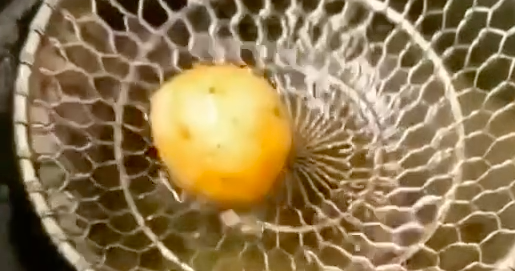Deep fry water: Tiktok’s latest trend
Tiktok users have been flocking to one weird new trend of attempting to deep fry water in hot oil. Is this possible and how safe, or actually how dangerous is it?
Watch the video on how to deep fry water:
The trend was started by TikTok user TrendyChef, who shows fans how to deep fry anything that can be fried. One particularly adventurous episode involves deep frying water. Of course, it is not pure water, H2O. A chemical, calcium alginate, is added to turn the water into little balls. What is calcium alginate and how does it help to deep fry water?
Calcium alginate:
Beautiful, or deadly? trendCredit: TikTok/@trendychef
Calcium alginate is an insoluble salt, and it appears as a gelatinous, pale-coloured substance. As an insoluble salt, we learn it in Chapter 12 Salt Preparation of the O Level Chemistry Syllabus. This is also taught in our O level and IP Classes. The insoluble salt of calcium alginate can be created through the addition of aqueous calcium chloride solution to aqueous sodium alginate solution.
Water balls are made using a chemical compound called calcium alginateCredit: TikTok/@trendychef
Sodium alginate can be prepared by extraction of the salt from seaweed or brown algae. The seaweed is firstly chopped into smaller pieces and added with hot sodium carbonate to form sodium alginate. The viscous solution (resistant to stirring) is filtered to remove cellulose to create sodium alginate solution. Thereafter, calcium chloride is added to form the precipitation of calcium alginate which is thus formed as a gel Commonly, it can be found in desserts, such as Agar-agar. . Calcium alginate is also used for entrapment of enzymes and forming artificial seeds in plant tissue culture.
How to deep fry water gel made of calcium alginate?
 Deep fry water step number 1:
Deep fry water step number 1:
Trendychef makes a solution of sodium alginate firstly, then adds calcium chloride to precipitate it. This forms a sphere of water ball that looks pretty cool. You can see this in molecular food in the form of desserts usually.
Deep fry water step number 2:
TrendyChef then covers the balls in flour, egg and breadcrumbs and drops it into the fryer to deep fry water.
The Danger
Now, assuming the water gel is at 25 C, which is room temperature, and it is placed in hot oil which is at 177 C, the vast difference in working temperatures is already a headache to work with. Why? Oil can violently spew when water is added to hot oil in a pan. When you deep fry water, the temperature of the water increases rapidly, and it may turn into a gas due to the large amount of heat energy transferred to it.
If the ball splits and the water leaks out into the oil, it is a recipe for disaster as the water is immiscible in oil, and the mixture can cause a sudden frenzied explosion of the chemicals in all direction. In addition, water boils and turns into steam at 100°C and in doing so it expands in volume by around 1,500 times nearly instantly, which could break the gel of water releasing the remaining volume into the oil.
Imagine hot vapor of steam flying in all direction. Do note that super heated vapor is the technology of air fryers, so essentially if you surround yourself with such chemicals in the cooking experiments, you are exposing yourself to air-drying yourself and your skin to extreme danger and heat. Don’t forget the oil flying in all directions due to its immiscible nature with water.
All in all, to deep fry water is to expose yourself to huge risks and you may hurt yourself in the process. There are more interesting and safer TikTok trends around which you can perform too! Try them instead of this!

Seb Academy Tuition Centre specialises in teaching O level Chemistry, A Level Chemistry to secondary school and JC students in Singapore. Our tutors deliver results consistently through engaging lesson plans, encouragement and constant follow-ups with their homework to ensure learning is on track to their A! Our O level Classes & IP Classes provides a comprehensive package for understanding chemistry concepts for the O Level Syllabus. The Program is rigorous and would provide a seamless transit for students looking to further tertiary education at A Levels H2 Chemistry or polytechnic courses. Also, do check out our new lower secondary classes offered! Seb Academy also offers virtual classes and a full fledged student’s portal where you can access a resourceful library of curated lectures, mini lectures, assessment and key answering shortcuts to help you to secure your A! Our Sec 3/4 Classes are helmed by Mr Sebastian Lim and Ms Sera, and Mr Sam Lee heads the A Level Chemistry Tuition Class division. Do read our interesting articles on our blog page for other content on academics, exam insights, Chemistry in every day lives. If you want to find more about our classes, do contact us today for more information!




 Deep fry water step number 1:
Deep fry water step number 1: